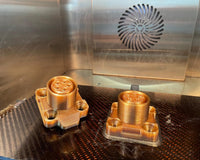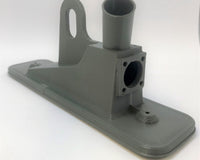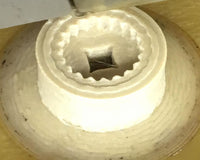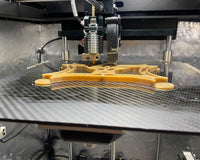The advent of new rapid prototyping techniques, like melt electrowriting, has revolutionized surgical mesh design. This breakthrough enables the creation of intricate geometries previously unattainable with conventional methods. By employing sinusoidal auxetic design, researchers aim to improve biocompatibility by mimicking the mechanical properties of vaginal soft tissue. These meshes exhibit dimensionally stable pores under tensile load, a limitation in current meshes. With the ability to control properties such as deformation and Young's modulus, along with high porosity and low weight, 3D printed meshes made of biodegradable PCL filament hold promise for enhancing surgical outcomes in pelvic organ prolapse repair.
The research focused on characterizing the mechanical properties of various biodegradable wavy PCL mesh structures, produced through Melt electrowriting (MEW). PCL, a widely utilized polymer in medical technology, finds applications in long-term implants, bone tissue engineering, and controlled drug delivery systems due to its low melting point of 60°C, making it highly suitable for 3D printing. Its solubility allows for the production of polymer-polymer blends, offering precise control over degradation time.
Previous studies demonstrated that melt electrowritten meshes can emulate the behavior of vaginal tissue within the comfort zone, corroborated by observations from Ren et al. Leveraging the precision of Melt electrowriting, fibers in the micrometer range and various mesh designs were produced. Employing Design of Experiment (DoE) methodologies, surgical meshes with diverse wavy geometries were crafted, subjected to uniaxial tensile tests, and statistically analyzed to establish a correlation between mesh geometry properties and mechanical characteristics.
The study's primary goal was to pioneer biodegradable mesh implants with the potential to reduce complications in the treatment of Pelvic Organ Prolapse (POP). This was achieved through the fine-tuning of mesh design and mechanical attributes, culminating in custom-made properties that mirror the unique mechanical composition of patient-specific vaginal soft tissue.
The study's specific objectives centered on developing meshes with an auxetic design. This involved the utilization of fibers with a controlled sinusoidal shape, featuring variable amplitude and wave count, achieved through the melt electrospinning writing process. The result? Meshes boasting properties harmonizing with those of vaginal tissue.
Read the entire study: https://onlinelibrary.wiley.com/doi/full/10.1002/app.54687






